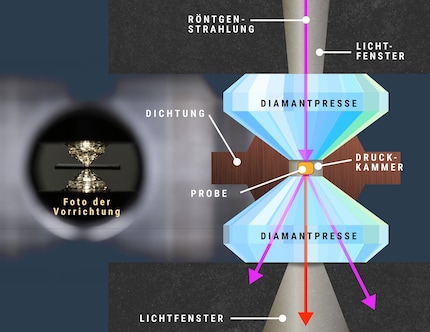
Superconductor world record at 15 °C
US researchers have succeeded in transporting electricity without loss at plus degrees in a laboratory experiment. However, important questions about the superconductivity experiment remain unanswered.
Perfect power cables, floating trains
Superconductivity has been a promise for more than 100 years. It holds out the prospect of cables without electrical resistance. They could be used to transmit electricity over long distances without loss, and more economical microchips and smaller MRIs are also conceivable. And as superconductors displace magnetic fields from their interior, some trams would probably make way for a Transrapid.
Unfortunately, nature has so far thwarted such dreams. The vast majority of materials only lose their electrical resistance near absolute zero at minus 273 degrees Celsius. And even "high-temperature" superconductors such as copper-containing cuprates still require liquid nitrogen at around minus 200 degrees as a coolant - and are usually very brittle.
Building plan for a superconductor
"That was the real milestone," says Lilia Boeri. "Everything that has happened since then is a logical consequence of that." In 2018, the Mainz-based researchers set the next record. According to this, the metal compound lanthanum decahydride (LaH10) is also a perfect conductor if it is compressed extremely strongly. And that at a comparatively warm 13 degrees below zero.
The remarkable thing about the Mainz results: Theorists had calculated in advance that the compounds would have to become superconducting under high pressure. With the chemically complex high-temperature superconductors from the cuprate family or the iron-based pnictides, such a prediction was practically never successful.
In the express through peer review
This time, things look better at first glance, confirm all the experts contacted by "Spektrum.de". However, the current publication also had to be done quickly: because of the huge competition in the field, he requested an extra fast peer review from the specialist journal "Nature", says Dias. He submitted the manuscript at the end of August. It then took just six weeks for the paper to be published - an unusually short period of time.
"It's hard to imagine that a thorough peer review took place during this time," criticises Graeme Ackland from the University of Edinburgh. At first glance, the study appears to be quite solid, but some important questions remain unanswered. Bernhard Keimer, Director at the Max Planck Institute for Solid State Research in Stuttgart, takes a similar view. "We don't actually know what kind of material it is," he says.
So far, it is completely unclear what lattice structure the sulphur, hydrogen and carbon atoms form in the tiny sample container used by Dias and his team. The previous record holder LaH10 was different: calculations showed that the hydrogen atoms form a kind of cage around the heavier foreign atom. This creates a symmetrical lattice that resembles that of metallic hydrogen.
Three is better than two
In the complex of C, S and H atoms from Dias' experiment, on the other hand, something else is more likely to favour superconductivity: It is possible that the three elements form extremely stable "covalent" bonds under pressure, which make the atomic lattice very rigid. As a result, vibrations could easily propagate through the material, bringing electrons together to form Cooper pairs. This is certainly the case with H3S, which was on the podium in 2015.
It remains to be seen whether this also explains the superconductivity of the new record holder. Measurements in which X-rays are scattered by the sample could have shed light on this, says Mainz-based competitor Mikhail Eremets. "It is a mystery why the team has not published such data."
Ranga Dias justifies this by saying that such measurements are not meaningful for C-S-H compounds and are generally overestimated in diamond pressing experiments. According to him, he and his team are working on a different X-ray method that should allow conclusions to be drawn about the atomic structure of the sample.
One way or another, theorists should now get to work. Over the next few months, they will be running various atomic lattice configurations through their computers to see which of them can reproduce the results of the experiment from Rochester. "That's the next race," says Lilia Boeri.
On the way to the next record
She believes that more and more records in room-temperature superconductivity will follow in the coming years. This is because researchers have only just started working on hydride compounds made from three elements. The periodic table offers a total of 1770 possible combinations.
In general, the experts hope that some of the three-element compounds will turn out to be easier-to-clean room-temperature superconductors, meaning they will retain their special properties even at low pressures. "In their current form, clamped in a diamond press, the materials are certainly not suitable for any application," says Bernhard Keimer.
Ranga Dias also recognises this. Nevertheless, he recently founded a company to earn money with his discovery. There is no business plan yet, he says. But that could still change if he and his team continue to experiment.
However, the history of superconductivity is a history of disappointed expectations. Even when the cuprate was discovered at the end of the 1980s, some researchers were convinced that the age of levitating trams was just around the corner. In the end, things turned out to be much more complicated than expected.
And so many researchers are rather sceptical when it comes to a superconductor that works its magic even at room temperature and without additional external pressure. "I think we will eventually find a material that can be used well at normal pressure and minus 100 degrees," says Lilia Boeri. That would be enough for some special applications - but probably not enough for the big material revolution.
[[small:]]
, via Wikimedia Commons
Experts from science and research report on the latest findings in their fields – competent, authentic and comprehensible.
From the latest iPhone to the return of 80s fashion. The editorial team will help you make sense of it all.
Show all